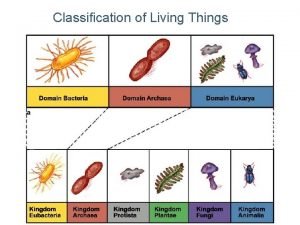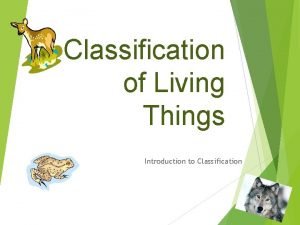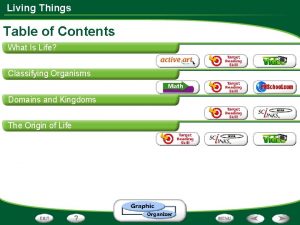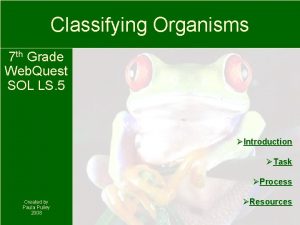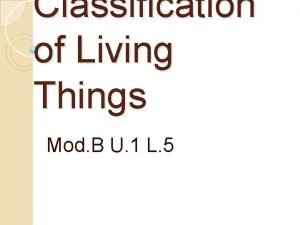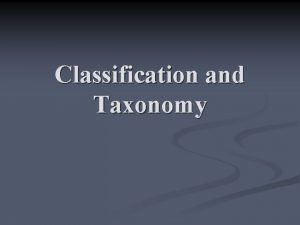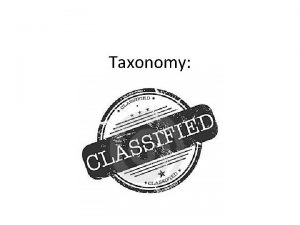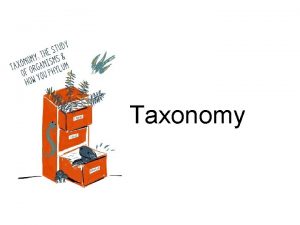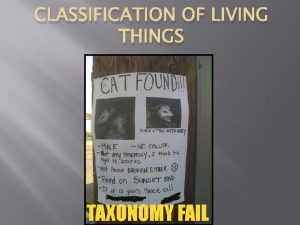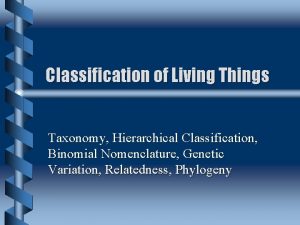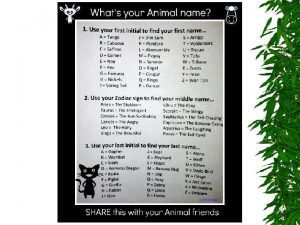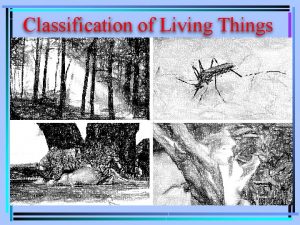Classification of Living Things Taxonomy is the science














- Slides: 14

Classification of Living Things Taxonomy is the science of classifying and naming organisms.

1 st Person to Classify Living Things • Aristotle – (384 – 322 B. C. ) – Greek philosopher, grouped plants and animals into separate kingdoms, then divided those 4

Latin • Each unit used was called a genus, which comes from the Latin word for group.

For example: The European honeybee’s name was: Apis pubescens thorace subgriseo abdominc fusco pedibus posticis glabis unfrinque margine ciliatus.

• Which means: • Hairy bee, underside of its thorax gray, abdomen striped, feet positioned to the rear, smooth, with outer areas on both sides having fine hairs.

• Carolus Linnaeus – (1707 -1778) – is called the father of modern taxonomy. • His goal was to catalog all known organisms. • By the 1750’s he had many books with polynomials for organisms that were completed. However, he used a two word Latin name for each organism. • For Example: • The European Honeybee became Apis mellifera.

Classification • From general to specific. • Domain – Most broad • Kingdom • Phylum • Class • Order • Family • Genus • Species – Most specific

Domain Kingdoms Characteristics Cell Type Cell Structure Examples Body Type Nutrition Example Bacteria Eubacteria Prokaryotic Cell wall Uni Auto & Hetero E. coli Archaebacteria Prokaryotic Cell wall Uni Auto & Hetero Methanogens Eukarya Protista Eukaryotic Mixed Uni & Multi Auto & Hetero Amoeba Euglena Eukarya Fungi Eukaryotic Cell wall Uni & Multi Hetero Yeast mushroom Eukarya Plantae Eukaryotic Cell wall Multi Auto Ferns Trees Eukarya Animalia Eukaryotic No Cell wall Multi Hetero Bird Worm


Phylogenic Tree • A phylogenic tree shows the evolutionary relationship between organisms. • The characteristics that make the next animal unique are listed on the main trunk of the tree.


Dichotomous keys • Dichotomous key – a special guide used to aid in identification of unknown organisms. • The key consists of several pairs of descriptive statements that have only two responses. • After picking the appropriate response the person is directed to the next pair of statements and eventually identifies the

• Examples: • Human – Homo sapiens Green Anole lizard – Anolis carolinensis Carolina Chickadee – Parus carolinensis • Both are from North & South Carolina. • Robin – North America – Turdus migratorius Great Britain – Erithacus rubicula

• Dichotomous key – a special guide used to aid in identification of unknown organisms. • The key consists of several pairs of descriptive statements that have only two responses. • After picking the appropriate response the person is directed to the next pair of statements and eventually identifies the organism.
 Living and nonliving things venn diagram
Living and nonliving things venn diagram The smallest living unit of all living things is
The smallest living unit of all living things is Life processes movement
Life processes movement Why do we classify things
Why do we classify things Categories of living things
Categories of living things Domain kingdom phylum mnemonic
Domain kingdom phylum mnemonic Thampi’s torrent frog
Thampi’s torrent frog Classification of living things notes
Classification of living things notes Domain of living things
Domain of living things Classification of living things webquest
Classification of living things webquest Classification of living things
Classification of living things The new taxonomy
The new taxonomy What's your subject
What's your subject Is moss living or non-living
Is moss living or non-living Living non living dead
Living non living dead



